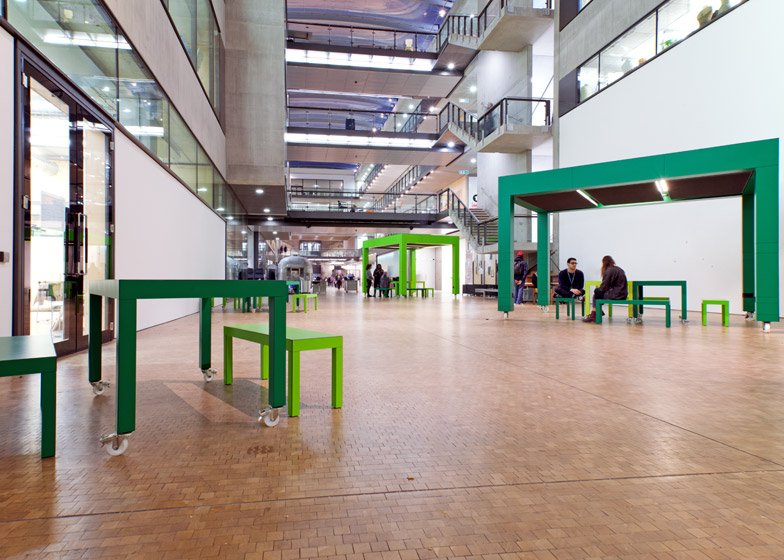London studio Featherstone Young Architects has designed a family of different-sized moveable tables as flexible workspaces for the atrium of art institution Central Saint Martins' King's Cross campus (+ slideshow).
Featherstone Young Architects designed the tables as part of a programme of projects that serve to make better use of the large internal "street" that runs through the centre of the Stanton Willams-designed building.
"There needed to be furniture or installations that could encourage people to use the street more as a place to meet, work or socialise - the vast scale and lack of power and light did not make this very conducive," Sarah Featherstone told Dezeen.
The architects came up with the idea of a family of movable tables that could be used in different ways by the staff and students, from teaching spaces to display plinths.
Sat on castors, the tables are designed in three colour-coded sets. Smaller tables can be stored inside the matching larger ones when not in use.
"They are like a nest of tables all of the same proportion and design, and colour coded to bring a uniformity and coherence to the new street furniture, which was replacing an array of rather muddled and mismatched tables and chairs," said Featherstone.
Each set is constructed from tables in three sizes. The largest piece in the yellow family is four metres high, while the biggest elements in the other two groups are both two-and-a-half metres tall.
"The largest table has curtains that can transform it into a space for film projections, lectures etc seating up to 40 people," said Featherstone. "The two medium ones have the flip-down display panels making these ideal spaces to have small presentations or meetings for 8-10 people around the family of smaller tables and benches beneath them."
The top of the largest table also features a pop-up lamp, which can be operated by a motorised switch to signal when an activity is taking place in the space underneath.
Built into the legs and underside of the large tables are fittings that compensate for the lack of infrastructure in the atrium.
These include lighting, power sockets, projectors, flip-down display panels, signage and hooks for hanging and displaying objects and students' work. The smaller tables provide seating and desk space for the students.
"Almost as soon as they were rolled out in to the street students were crawling all over them working out what they can do, eliciting impromptu performances and screenings in them," said Featherstone. "We have even had an enquiry from the Department of Education who would like to use them in a similar way in the large atrium spaces of some of the new Academy schools."
The tables were built by fabricators Millimetre, who also worked with the architects to develop structural and construction details.
Past projects by Featherstone Young Architects include a daycare centre for homeless people, clad in stripes of green and yellow perforated panels, and a house cantilevered over a river in Wales.


















